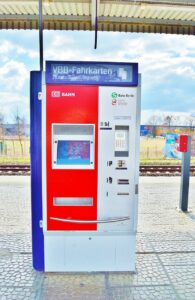Table of Contents
ToggleTRAVELING BY TRAIN IN EUROPE: A COMPREHENSIVE GUIDE
Traveling by train in Europe is a unique and exciting experience that offers travelers the opportunity to explore different countries and cultures in a comfortable and sustainable way. With an extensive network of rail lines and high-speed trains, traveling by train in Europe is fast, efficient, and affordable, making it the preferred mode of transportation for many travelers.
One of the main advantages of traveling by train in Europe is the convenience it offers. With frequent departures and arrivals, travelers can easily plan their itinerary and move from one city to another without having to worry about traffic or parking. Moreover, trains are equipped with comfortable seats, ample legroom, and amenities such as WiFi and food service, making long journeys more comfortable and enjoyable.
Another advantage of traveling by train in Europe is the opportunity to see the scenic countryside and picturesque towns that are often missed when traveling by plane or car. Train routes often pass through stunning landscapes, mountains, and valleys, providing travelers with a unique and unforgettable experience. Additionally, train stations are often located in the heart of the city, making it easy for travelers to explore the local attractions and landmarks.
Where to stay: Click here for information.
Helpful tips:
Using eSim card will give you coverage worldwide with one provider and one payment. Click here for info.
Where to eat: Restaurants with ratings and reviews. Click TripAdvisor.
Travel Insurance: Click here for information.
Advantages of Traveling by Train in Europe

Traveling by train in Europe has many advantages over other modes of transportation. In this section, we will explore some of the most significant advantages of train travel in Europe.
Cost-Effective
Train travel in Europe is often a cost-effective option for travelers. While the initial cost of a train ticket may be higher than a bus or plane ticket, there are often no hidden fees or extra charges. Additionally, train travel can be more affordable for travelers who plan to visit multiple destinations, as many rail companies offer discounted passes for multiple journeys. For example, Eurail offers a range of passes that allow travelers to explore up to 33 countries in Europe. To purchase tickets click here.
Comfort and Convenience
Train travel in Europe is generally more comfortable and convenient than other modes of transportation. Trains offer more legroom than planes and buses, and many trains have amenities such as dining cars, Wi-Fi, and power outlets. Additionally, train stations are often located in the heart of cities, making it easy for travelers to get to their accommodations and explore the city.
Scenic Routes

One of the most significant advantages of train travel in Europe is the opportunity to take in the stunning scenery. Many train routes in Europe pass through picturesque countryside, mountains, and coastal areas. For example, the Glacier Express in Switzerland is known for its breathtaking views of the Swiss Alps, while the West Highland Line in Scotland passes through rugged landscapes and historic towns.
In summary, train travel in Europe offers many advantages, including cost-effectiveness, comfort and convenience, and scenic routes. Travelers who are looking for an affordable, comfortable, and picturesque way to explore Europe should consider traveling by train.
Choosing the Right Train Pass
 When planning a trip to Europe, many travelers consider traveling by train. Train travel is a comfortable and convenient way to explore the continent, offering scenic routes, easy access to city centers, and the ability to cover long distances quickly. However, choosing the right train pass can be a daunting task. In this section, we will explore the different types of train passes, compare costs, and discuss duration and validity.
When planning a trip to Europe, many travelers consider traveling by train. Train travel is a comfortable and convenient way to explore the continent, offering scenic routes, easy access to city centers, and the ability to cover long distances quickly. However, choosing the right train pass can be a daunting task. In this section, we will explore the different types of train passes, compare costs, and discuss duration and validity.
Types of Train Passes
There are several types of train passes available in Europe. The most popular are the Eurail Pass and the Interrail Pass. The Eurail Pass is available to non-European residents, while the Interrail Pass is available to European residents. Both passes offer different options, including:
- Global Pass: Allows unlimited travel in 33 countries.
- One-Country Pass: Allows unlimited travel in one country.
- Flexi Pass: Allows a certain number of travel days within a set period.
- Continuous Pass: Allows unlimited travel for a set period.
Cost Comparison
The cost of a train pass depends on several factors, including the type of pass, the number of travel days, and the class of travel. For example, a 10-day Eurail Global Pass for first class travel costs around $750, while a second class pass costs around $600. A 10-day Interrail Global Pass for first class travel costs around €670, while a second class pass costs around €500.
While train passes can seem expensive at first glance, they can be a cost-effective option for those planning to travel extensively. It is important to compare the cost of a train pass to the cost of individual train tickets for each leg of your journey to determine which option is best for you.
Duration and Validity
The duration and validity of a train pass vary depending on the type of pass. For example, a Eurail Global Pass is valid for 15 days to three months, depending on the pass type, while an Interrail Global Pass is valid for 15 days to one month. It is important to note that travel days are consecutive for a Flexi Pass, while they can be non-consecutive for a Continuous Pass.
It is also important to note that some trains require reservations, which can cost an additional fee. Reservations are required for most high-speed trains and overnight trains, and can cost anywhere from €10 to €30 per reservation.
Overall, choosing the right train pass depends on your travel plans and budget. It is important to research and compare different pass options to find the best fit for your trip.
Booking Train Tickets

When traveling by train in Europe, one of the most important aspects is booking train tickets. There are several ways to book train tickets, including online booking, in-person booking, and tips for booking.
Online Booking
Online booking is one of the most convenient ways to book train tickets in Europe. There are several websites that allow travelers to search for train routes, compare prices, and purchase tickets. Some popular websites include Rail Europe, Eurail, Omio, and Trainline.
When booking train tickets online, it is important to make sure that the website is legitimate and secure. Travelers should also check the terms and conditions of the website to ensure that they understand the cancellation and refund policies.
In-Person Booking
In-person booking is another option for travelers who prefer to book train tickets in person. Train stations in Europe typically have ticket counters or machines where travelers can purchase tickets. This option may be beneficial for travelers who have questions or concerns about their itinerary and would like to speak with a representative in person.
When booking train tickets in person, travelers should make sure that they have all the necessary information, such as the date and time of travel, the departure and arrival stations, and the type of ticket they need.
Tips for Booking
When booking train tickets in Europe, there are several tips that travelers should keep in mind:
- Book in advance: Train tickets in Europe can sell out quickly, especially during peak travel seasons. It is recommended that travelers book their tickets in advance to ensure availability and to take advantage of early bird discounts.
- Be flexible: Travelers who are flexible with their travel dates and times may be able to find cheaper train tickets.
- Consider different ticket types: Train tickets in Europe come in different types, such as standard, first class, and sleeper cabins. Travelers should consider their budget and travel needs when choosing a ticket type.
- Check for discounts: Some train companies in Europe offer discounts for students, seniors, and families. Travelers should check for discounts before booking their tickets.
Overall, booking train tickets in Europe can be a simple and convenient process. By using online booking, in-person booking, and following these tips, travelers can ensure a smooth and stress-free travel experience.
Preparing for the Train Journey
 Traveling by train in Europe is a convenient and cost-effective way to explore the continent. However, before embarking on a train journey, it is important to prepare adequately to ensure a smooth and enjoyable experience. This section will cover the essential items to pack, what to expect when boarding the train, and the facilities available on board.
Traveling by train in Europe is a convenient and cost-effective way to explore the continent. However, before embarking on a train journey, it is important to prepare adequately to ensure a smooth and enjoyable experience. This section will cover the essential items to pack, what to expect when boarding the train, and the facilities available on board.
Packing Essentials
When packing for a train journey, it is important to keep in mind that space is often limited, especially if traveling on a budget. It is recommended to pack light and only bring the essentials. Here are some items that should be included in every train traveler’s packing list:
- Valid passport or ID
- Train tickets or rail pass
- Comfortable clothing and shoes
- Travel pillow and blanket
- Toiletries
- Snacks and water
- Electronic devices and chargers
- Cash and credit cards
Boarding the Train
When arriving at the train station, it is important to check the departure board for the correct platform and time. It is recommended to arrive at the station at least 30 minutes before departure to allow ample time to navigate the station and board the train.
Once on the train, locate the assigned seat or cabin and store luggage in the designated area. It is important to keep valuables and important documents with you at all times. Train travel in Europe is generally safe, but it is always better to be cautious.
On-Board Facilities
Most trains in Europe offer a range of facilities to make the journey more comfortable. These can include:
- Restrooms
- Food and drink service
- Power outlets
- Wi-Fi (available on some trains)
- Luggage storage
- Air conditioning or heating
It is important to note that not all trains offer the same facilities, and some may require an additional fee. It is recommended to research the train company and type of train before booking to ensure that it meets your needs and expectations.
Overall, preparing for a train journey in Europe requires some planning and preparation. By packing the essentials, understanding the boarding process, and knowing the on-board facilities, travelers can enjoy a comfortable and stress-free journey.
Tips for a Smooth Train Journey
Traveling by train in Europe can be an enjoyable and efficient way to explore the continent. However, it is important to be prepared and know what to expect to ensure a smooth journey. Here are some tips to help make your train travel experience in Europe as stress-free as possible.
Navigating Train Stations
Train stations in Europe can be large and busy, especially in major cities. It is important to arrive early and allow plenty of time to find your platform and board your train. Here are some tips to help navigate train stations:
- Check the departure board: Look for your train number, destination, and departure time. Make sure to double-check the platform number as it can change at the last minute.
- Follow the signs: Look for signs pointing to your platform and follow the arrows.
- Ask for help: Don’t be afraid to ask station staff or other travelers for help if you are unsure where to go.
- Keep your ticket and passport handy: You will need to show your ticket and passport to board the train, so keep them easily accessible.
Dealing with Delays and Cancellations
While train travel in Europe is generally reliable, delays and cancellations can happen. Here are some tips to help deal with these situations:
- Check for updates: Look for departure board updates or check the train company’s website or social media for the latest information.
- Be prepared: Have a backup plan in case of a delay or cancellation, such as alternative transportation or accommodation options.
- Know your rights: If your train is delayed or cancelled, you may be entitled to compensation or a refund. Check with the train company for their policies and procedures.
Safety and Security Measures
Train travel in Europe is generally safe, but it is important to take precautions to protect yourself and your belongings. Here are some tips to help ensure your safety:
- Keep an eye on your belongings: Don’t leave your bags unattended and keep them close to you at all times.
- Use a luggage lock: Secure your bags with a luggage lock to deter theft.
- Be aware of your surroundings: Keep an eye out for suspicious behavior or unattended bags.
- Follow safety instructions: Listen to announcements and follow safety instructions in case of an emergency.
By following these tips, you can help ensure a smooth and enjoyable train travel experience in Europe.
FAQ
Here are some common questions and answers about traveling by train in Europe:
Q: Is it cheaper to buy train tickets in advance or on the day of travel?
A: In general, it’s cheaper to buy train tickets in advance. Many European train companies offer discounted fares for tickets purchased ahead of time. However, there are some exceptions, such as regional trains or last-minute deals, where buying tickets on the day of travel might be cheaper. It’s always a good idea to compare prices and check for promotions before making a purchase.
Q: How early should I arrive at the train station?
A: It’s recommended to arrive at the train station at least 30 minutes before departure time. This allows enough time to find the correct platform, locate your train car, and stow your luggage. Some larger train stations, such as Paris Gare du Nord or London St. Pancras, may require more time for navigating.
Q: Can I bring luggage on the train?
A: Yes, you can bring luggage on the train. However, there are restrictions on the size and weight of luggage. Most train companies allow up to two pieces of luggage per person, with a maximum weight of 32kg (70lbs) per piece. It’s important to check the specific luggage policy of the train company before traveling.
Q: Are there food and drink options on the train?
A: Many long-distance trains in Europe have dining cars or onboard cafes where passengers can purchase food and drinks. However, the selection and quality of food may vary depending on the train company and route. It’s always a good idea to bring your own snacks and drinks, especially on shorter trips.
Q: Do I need to validate my train ticket?
A: It depends on the type of ticket and the country you’re traveling in. Some train tickets, such as e-tickets or print-at-home tickets, do not need to be validated. However, paper tickets or tickets purchased from a ticket machine may need to be validated before boarding the train. Validation machines are usually located near the platform or at the entrance of the station.
Disclosure: Please note that some links on this website are affliate links. At no cost to you, I receive commission if you make a purchase. I only recommend companies that I research and would use.


